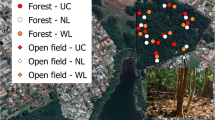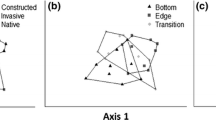Abstract
Desiccation cracks are a natural phenomenon of clay-rich soils that form via soil shrinkage during dry conditions. Our aim was to test the seed trapping potential of such cracks and assess its impact on seed bank formation in a flood-meadow ecosystem. We documented crack patterns on permanent plots and analysed the soil seed content along and adjacent to cracks. Seed translocation via cracks was tested with a mark-recapture experiment, and post-entrapment seed fate was tested with a burial experiment. Most cracks re-opened in the same positions in consecutive dry periods. Along cracks, most seeds were found in 10–20 cm depth, whereas adjacent to cracks most seeds were found in 0–5 cm depth. The majority of seeds found in shallow depths adjacent to cracks belonged to species that were also present in the above-ground vegetation, whereas this rate was always under 50% along desiccation cracks. The mark-recapture experiment gave evidence for vertical seed translocation through desiccation cracks. Post-entrapment seed fate differed between species and burial depth, with a trend towards increasing survival with increasing depth. We conclude that desiccation cracks act as natural seed traps, foster seed bank formation and thus influence plant community dynamics in flood meadow systems.





Similar content being viewed by others
References
Bakker JP, Poschlod P, Strykstra RJ, Bekker RM, Thompson K (1996) Seed banks and seed dispersal: important topics in restoration ecology. Acta Bot Neerl 45:461–490
Baskin CC, Baskin JM (2001) Seeds. Ecology, biogeography, and evolution of dormancy and germination. Academic, San Diego
Benvenuti S (1995) Soil light penetration and dormancy of Jimsonweed (Datura stramonium) seeds. Weed Sci 43:389–393
Benvenuti S (2007) Natural weed seed burial: effect of soil texture, rain and seed characteristics. Seed Sci Res 17:211–219
Benvenuti S, Macchia M, Miele S (2001) Quantitative analysis of emergence of seedlings from buried weed seeds with increasing soil depth. Weed Sci 49:528–535
Bond WJ, Honig M, Maze KE (1999) Seed size and seedling emergence: an allometric relationship and some ecological implications. Oecologia 120:132–136
Bonis A, Lepart J (1994) Vertical structure of seed banks and the impact of depth of burial on recruitment in two temporary marshes. Vegetatio 112:127–139
Burmeier S, Eckstein RL, Donath TW, Otte A (in press) Plant pattern development during early post-restoration succession in grasslands - a case study of Arabis nemorensis. Rest Ecol
Cabin RJ, Marshall DL, Mitchell RJ (2000) The demographic role of soil seed banks. II. Investigations of the fate of experimental seeds of the desert mustard Lesquerella fendleri. J Ecol 88:293–302
Cain ML, Milligan BG, Strand AE (2000) Long-distance seed dispersal in plant populations. Am J Bot 87:1217–1227
Chambers JC, MacMahon JA (1994) A day in the life of a seed: movements and fates of seeds and their implications for natural and managed systems. Annu Rev Ecol Syst 25:263–292
Chambers JC, MacMahon JA, Haefner JH (1991) Seed entrapment in alpine ecosystems: effects of soil particle size and diaspore morphology. Ecology 72:1668–1677
Chertkov VY (2002) Modelling cracking stages of saturated soils as they dry and shrink. Eur J Soil Sci 53:105–118
Chertkov VY (2005) The shrinkage geometry factor of a soil layer. Soil Sci Soc Am J 69:1671–1683
Cornelis WM, Corluy J, Medina H, Hartmann R, Van Meirvenne M, Ruiz ME (2006) A simplified parametric model to describe the magnitude and geometry of soil shrinkage. Eur J Soil Sci 57:258–268
Cussans GW, Raudonius S, Brain P, Cumberworth S (1996) Effects of depth of seed burial and soil aggregate size on seedling emergence of Alopecurus myosuroides, Galium aparine, Stellaria media and wheat. Weed Res 36:133–141
Davis AS, Renner KA (2007) Influence of seed depth and pathogens on fatal germination of velvetleaf (Abutilon theophrasti) and giant foxtail (Setaria faberi). Weed Sci 55:30–35
Donath TW, Eckstein RL (2009) Effects of bryophyte and grass litter on seedling emergence vary by vertical seed position and seed size. Plant Ecol. doi:10.1007/s11258-009-9670-8
Donath TW, Hölzel N, Otte A (2003) The impact of site conditions and seed dispersal on restoration success in alluvial meadows. Appl Veg Sci 6:13–22
Donath TW, Bissels S, Hölzel N, Otte A (2007) Large scale application of diaspore transfer with plant material in restoration practice—Impact of seed and microsite limitation. Biol Conserv 138:224–234
Edwards GR, Crawley MJ (1999) Rodent seed predation and seedling recruitment in mesic grassland. Oecologia 118:288–296
Elberling H (2000) Spatial pattern of Lesquerella arctica: effects of seed bank and desiccation cracks. Ecoscience 7:86–91
Espinar JL, Clemente L (2007) The impact of vertic soil cracks on submerged macrophyte diaspore bank depth distribution in Mediterranean temporary wetlands. Aquat Bot 87:325–328
Espinar JL, Thompson K, Garcia LV (2005) Timing of seed dispersal generates a bimodal seed bank depth distribution. Am J Bot 92:1759–1763
Forcella F, Arnold RLB, Sanchez R, Ghersa CM (2000) Modeling seedling emergence. Field Crop Res 67:123–139
Grime JP (2001) Plant strategies, vegetation processes, and ecosystem properties. Wiley, Chichester
Grundy AC, Mead A, Burston S (2003) Modelling the emergence response of weed seeds to burial depth: interactions with seed density, weight and shape. J Appl Ecol 40:757–770
Hallett PD, Newson TA (2005) Describing soil crack formation using elastic-plastic fracture mechanics. Eur J Soil Sci 56:31–38
Hölzel N, Otte A (2004a) Assessing soil seed bank persistence in flood-meadows: the search for reliable traits. J Veg Sci 15:93–100
Hölzel N, Otte A (2004b) Ecological significance of seed germination characteristics in flood-meadow species. Flora 199:12–24
IUSS Working Group WRB (2007) World reference base for soil resources 2006, first update 2007. World Soil Resources Reports No. 103. FAO, Rome
Joyce CB, Wade MW (1998) Wet grasslands: a European perspective. In: Joyce CB, Wade PM (eds) European wet grasslands: biodiversity, management and restoration. Wiley, Chichester, pp 1–12
Kazanci N, Emre O, Alcicek MG (2001) Animal burrowing and associated formation of large desiccation cracks as factors of a rapid restoration of soil cover in flooded farmlands. Environ Geol 40:964–967
Kishne AS, Morgan CLS, Miller WL (2009) Vertisol crack extent associated with gilgai and soil moisture in the Texas Gulf Coast Prairie. Soil Sci Soc Am J 73:1221–1230
Klotz S, Kühn I, Durka W (eds) (2002) BIOLFLOR—Eine Datenbank zu biologisch-ökologischen Merkmalen der Gefäßpflanzen in Deutschland. Bundesamt für Naturschutz, Bonn
Leck MA, Parker VT, Simpson RL (eds) (1989) Ecology of soil seed banks. Academic, San Diego
Milberg P, Andersson L, Thompson K (2000) Large-seeded species are less dependent on light for germination than small-seeded ones. Seed Sci Res 10:99–104
Oliveira MJ, Norsworthy JK (2006) Pitted morningglory (Ipomoea lacunosa) germination and emergence as affected by environmental factors and seeding depth. Weed Sci 54:910–916
Poschlod P, Kleyer M, Jackel AK, Dannemann A, Tackenberg O (2003) BIOPOP—a database of plant traits and Internet application for nature conservation. Folia Geobot 38:263–271
Quinn GP, Keough MJ (2002) Experimental design and data analysis for biologists. Cambridge University Press, Cambridge
Rayhani MHT, Yanful EK, Fakher A (2008) Physical modeling of desiccation cracking in plastic soils. Eng Geol 97:25–31
Redmann RE, Qi MQ (1992) Impacts of seeding depth on emergence and seedling structure in eight perennial grasses. Can J Bot 70:133–139
Roberts HA (1981) Seed banks in soils. In: Coaker TH (ed) Advancements in applied biology 6. Academic, Cambridge, pp 1–55
Schmiede R, Donath TW, Otte A (2009) Seed bank development after the restoration of alluvial grassland via transfer of seed-containing plant material. Biol Conserv 142:404–413
Taki O, Godwin RJ, Leeds-Harrison PB (2006) The creation of longitudinal cracks in shrinking soils to enhance seedling emergence. Part I. The effect of soil structure. Soil Use Manage 22:1–10
Tang CS, Shi B, Liu C, Zhao LZ, Wang BJ (2008) Influencing factors of geometrical structure of surface shrinkage cracks in clayey soils. Eng Geol 101:204–217
Telewski FW, Zeevaart JAD (2002) The 120-yr period for Dr. Beal’s seed viability experiment. Am J Bot 89:1285–1288
Thompson K (2000) The functional ecology of soil seed banks. In: Fenner M (ed) Seeds: the ecology of regeneration in plant communities. CABI, Wallingford, pp 215–235
Thompson K, Grime JP (1983) A comparative study of germination responses to diurnally-fluctuating temperatures. J Appl Ecol 20:141–156
Thompson K, Band SR, Hodgson JG (1993) Seed size and shape predict persistence in soil. Funct Ecol 7:236–241
Thompson K, Bakker JP, Bekker RM, Hodgson JG (1998) Ecological correlates of seed persistence in soil in the north-west European flora. J Ecol 86:163–169
Tielbörger K, Prasse R (2009) Do seeds sense each other? Testing for density-dependent germination in desert perennial plants. Oikos 118:792–800
Underwood AJ (1997) Experiments in ecology. Cambridge University Press, Cambridge
Velde B, Moreau E, Terribile F (1996) Pore networks in an Italian Vertisol: quantitative characterisation by two dimensional image analysis. Geoderma 72:271–285
Vleeshouwers LM, Bouwmeester HJ, Karssen CM (1995) Redefining seed dormancy: an attempt to integrate physiology and ecology. J Ecol 83:1031–1037
Vogel HJ, Hoffmann H, Leopold A, Roth K (2005a) Studies of crack dynamics in clay soil II. A physically based model for crack formation. Geoderma 125:213–223
Vogel HJ, Hoffmann H, Roth K (2005b) Studies of crack dynamics in clay soil I. Experimental methods, results, and morphological quantification. Geoderma 125:203–211
Westerman PR, Wes JS, Kropff MJ, Van der Werf W (2003) Annual losses of weed seeds due to predation in organic cereal fields. J Appl Ecol 40:824–836
Wisskirchen R, Haeupler H (1998) Standardliste der Farn- und Blütenpflanzen Deutschlands. Ulmer, Stuttgart
Woolley JT, Stoller EW (1978) Light penetration and light-induces seed germination in soil. Plant Physiol 61:597–600
Yanful M, Maun MA (1996) Effects of burial of seeds and seedlings from different seed sizes on the emergence and growth of Strophostyles helvola. Can J Bot 74:1322–1330
Yesiller N, Miller CJ, Inci G, Yaldo K (2000) Desiccation and cracking behavior of three compacted landfill liner soils. Eng Geol 57:105–121
Zhang J, Maun MA (1994) Potential for seed bank formation in seven Great Lakes sand dune species. Am J Bot 81:387–394
Acknowledgements
We thank Josef Scholz vom Hofe, Christiane Lenz-Kuhl, Jennifer Branch and Simon Kohling for their assistance in the field and in the laboratory, Ralf Schmiede for editing and processing the desiccation crack images, Christian Albrecht for soil classification and Melanie Kühlmann for soil particle size analysis. Comments of Eszter Ruprecht and two anonymous referees considerably improved this paper. The study was funded by the Deutsche Forschungsgemeinschaft DFG (project number: OT 167/3-1).
Author information
Authors and Affiliations
Corresponding author
Additional information
Responsible Editor: Jeffrey Walck.
Electronic supplementary material
Below is the link to the electronic supplementary material.
Online Resource 1
Soil characterization of the study sites (PDF 4 kb)
Online Resource 2
Seed density (seeds/m2, mean ± SE, 2037 seeds/m2 = 1 seed/sample) and frequency (f; % occurrence in 140 samples) of the species present in the soil seed bank of the study sites (PDF 15 kb)
Online Resource 3
Daily soil temperature amplitudes in different soil depths at the burial site throughout the course of experiment 2 (Oct 2007-Oct 2009). Temperatures were recorded in 4-hour intervals. Arrows indicate excavation dates (PDF 61 kb)
Rights and permissions
About this article
Cite this article
Burmeier, S., Eckstein, R.L., Otte, A. et al. Desiccation cracks act as natural seed traps in flood-meadow systems. Plant Soil 333, 351–364 (2010). https://doi.org/10.1007/s11104-010-0350-1
Received:
Accepted:
Published:
Issue Date:
DOI: https://doi.org/10.1007/s11104-010-0350-1




